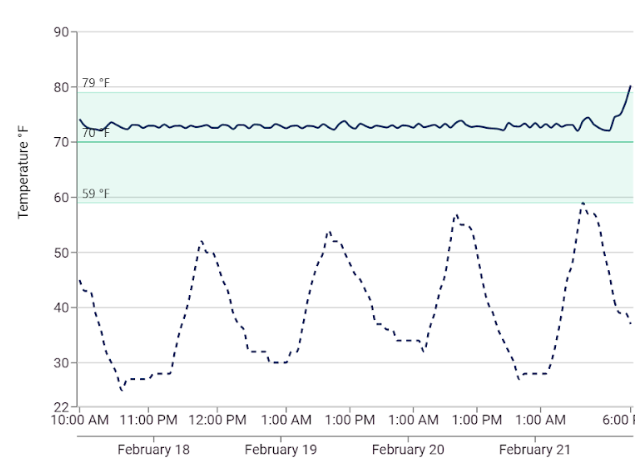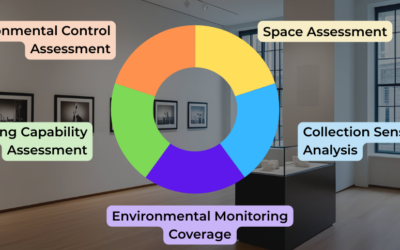One of the major goals of a data monitoring program is to eventually make improvements to your collection environment.
These improvements can be in the form of reduced energy consumption, changes to increase the longevity of the collection materials, or a combination of the two.
Actively adjusting temperature, humidity, light, and the collection’s physical surroundings are the environmental control measures that will help to achieve these goals.
Establish baseline data to evaluate the current environment
The key is to know when you have enough data to make an educated decision. The primary recommendation is to have at least one full year of data from loggers that have stayed in the same location. This information will tell you how changes in seasons, storms, power issues, etc. can influence your collection spaces.
Begin by evaluating the environment that you are currently creating in your collection spaces. This should be an assessment of the set points that are being implemented, as well as the condition the mechanical system is capable of producing, and that the building is capable of holding.
What are your set points for?
Are the temperature and RH conditions that you are requesting appropriate for the long-term preservation of the collection materials? Many institutions implement set points of 70˚F(20˚C)/50%RH for their collection spaces, including long term storage spaces. This condition can be costly to maintain in many circumstances.
Research has proven that the longevity of many collection materials can be extended by cooler temperatures and regulating the relative humidity between 30-55%.
Depending on the type of mechanical system that an institution uses, reducing the temperature in a collection space may actually use less energy, while also improving the preservation quality of the environment.
Use dew point to understand system performance and building capability
Dew point is one of the most critical systems of measurement for a collection environment. Dew point is a better way to understand the moisture content of the air in your space. Assessing dew point can help paint a picture of what you may be able to expect from your facility.
If there are periods of high moisture outside and there are corresponding spikes inside of your facility these may be signs that your building or mechanical system allows moisture to pass through.
If your collection space starts off with a great dew point during the humid months, but as the years pass the dew point rises, this may be a sign of failure in a mechanical system. This information is very important when trying to plan your environment.
Evaluating your data in the humid months you can discern the dew point that you can expect to achieve in the collection spaces.
Using software like dpcalc.org, you can plot your dew point and test what temperature and RH combinations can be achieved in your collection space, keeping in mind that you do not want to exceed an RH limit of 55%.
This can help determine the best conditions that can be achieved in a collection space during the humid months. During dry months start by setting the average outdoor dew point in the software. Then begin to adjust your temperature and RH to the best conditions for your collection.
Other factors play a role in your ability to control your collection environment. Some of these are history of the facility, the layout of spaces, and occupancy. Understanding each of these may help paint a clearer picture of what you may be able to implement for energy control strategies.
Passive space conditioning
Not all collection spaces have mechanical systems. Some historic houses may have little to no forms of conditioning while others may have only baseboard heat. Even these intuitions can identify some methods of energy saving.
Start outside and move moisture away
The grounds of the facility offer a great place to start when addressing a collection environment.
All facilities should ensure that the means for moving moisture away from the building (gutters, landscaping, roofs) are in excellent shape and are designed to move moisture as far away from the foundation as possible.
Standing water around the perimeter of a building will allow moisture to seep into a structure and result in high interior dew points.
Storage furniture as environmental control
One of the most successful methods that can be implemented, especially in a space with little to no conditioning is the use of storage furniture. Properly gasketed and sealed storage furniture can provide substantial buffering of the materials from surrounding conditions.
In some cases, we have seen significant temperature and RH swings of a historic house, while a gasketed cabinet storing collection materials saw little to no influence on the RH from the surrounding space.
The key is to ensure that the gasketed cabinet stays as closed as possible during periods of high humidity.
Lighting reduction saves energy
Lighting reduction is a strategy that almost every intuition can achieve. Whether it is changing fluorescent bulbs to LEDs, reducing lighting hours, or reducing the number of lights in a space, there is likely some waste at an institution. Be sure to fully assess your lighting needs to determine if you are running the appropriate amount of light for your requirements.
Can you lower the temperature?
A last strategy to consider for passive needs may be to evaluate your facility’s heating needs.
We worked with a historic building that was closed 6 months out of the year but heated the empty buildings to 70˚ just in case.
In this scenario is the heat necessary? The facilities are vacant and the collection would benefit from cooler conditions, as a result we were able to reduce the heating to around 50˚F so the plumbing in the facility was not at risk, while at the same time improving the quality of the preservation environment for the collection.
Strategies for spaces with mechanical systems
Many sites do utilize HVAC systems to condition their collection environment. For these sites the energy saving strategies can be more straightforward and yield greater results.
Scheduled shutdowns
The biggest energy reducing strategy that can be implemented in a collection space is scheduled system shutdowns.
In this scenario a mechanical system is turned off for a determined number of hours.
Though the preservation benefits from this may be limited, the energy savings can be significant. A great way to evaluate how your facility may operate during shutdowns is to assess building data from power outages or maintenance shutdowns. This data can show how long your building may last with the mechanical system off before any changes to interior conditions occur.
Setbacks
A secondary strategy that can be implemented is the use of setbacks. These can take the form of daily setbacks or seasonal setbacks. These setbacks are adjustments in temperature and RH for a determined amount of time.
Daily setbacks involve using one set of temperature and RH set points during the day and a second set during closed or unoccupied hours.
Seasonal set points involve using one set of temp and RH set points for the warm/ humid months and a second set for the cold/dry months. (For example in a collection storage space, utilizing set points of 70˚F/55%RH in warm/humid months and set points of 65˚F/35% RH in the cold/dry months.) These strategies may not yield as significant energy savings as shutdowns but they will provide periods of improved preservation in the collection spaces.
Minimize outside air
One last major strategy to utilize within your collection space is the reduction of outside air usage. Most mechanical systems utilize some volume of outside air. A certain amount is mandated by local and state codes, and is necessary to remove off gassing. However, many institutions use more than is required.
Any amount of outside air that is consumed by the system requires energy to condition the incoming air for the collection space.
Reducing this amount of air to a minimum can place less sensible and latent loads on the system, reducing their energy consumption for treating the air.
Environmental control starts with monitoring data
The implementation of any strategy requires a fair knowledge of your collection needs, building, and mechanical system. The data you collect is a significant portion of that. A strong data monitoring program is one major tool in learning how to best control your collection environment.
Hear more from sustainable preservation expert Christopher Cameron in the Conserv Community.
If you have any questions about environmental monitoring, integrated pest management, or just want to talk about preventative conservation, please reach out to us! Don’t forget to check out our blog or join our community of collections care professionals where you can discuss hot topics, connect with other conservators or even take a course to get familiar with the Conserv platform.





